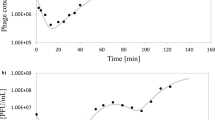Abstract
Bacteriophage materials have the potential to revolutionize medicine, energy production and storage, agriculture, solar cells, optics and many other fields. To fulfill these needs, this study examined critical process parameters during phage propagation to increase phage production capability. A representative scale-down system was created in tube spin reactors to allow parallel experimentation with single- and multi-variable analysis. Temperature, harvest time, media composition, feed regime, bacteriophage, and bacteria concentration were analyzed in the scale-down system. Temperature, media composition, and feeding regimens were found to affect phage production more than other factors. Temperature affected bacterial growth and phage production inversely. Multi-variate analysis identified an optimal parameter space which provided a significant improvement over the base line method. This method should be useful in scaled production of bacteriophage for biotechnology.



Similar content being viewed by others
References
Hendrix RW (2002) Bacteriophages: evolution of the majority. Theor Popul Biol 61:471–480
Lee YJ, Yi H, Kim WJ, Kang K, Yun DS, Strano MS, Ceder G, Belcher AM (2009) Fabricating genetically engineered high-power lithium-ion batteries using multiple virus genes. Science 324(5930):1051–1055
Nam KT, Kim DW, Yoo PJ, Chiang CY, Meetong N, Hammond PT, Chiang YM, Belcher AM (2006) Virus-enabled synthesis and assembly of nanowires for lithium ion battery electrodes. Science 312(5775):885–888
Chen PY, Dang X, Klug MT, Qi J, Courchesne NMD, Burpo FJ, Fang N, Hammond PT, Belcher AM (2013) Versatile three-dimensional virus-based template for dye-sensitized solar cells with improved electron transport and light harvesting. ACS Nano 7(8):6563–6574
Kim TH, Lee BY, Jaworski J, Yokoyama K, Chung WJ, Wang E, Hong S, Majumdar A, Lee SW (2011) Selective and sensitive TNT sensors using biomimetic polydiacetylene-coated CNT-FETs. ACS Nano 5(4):2824
Sadegh SM, Hood B, Patty KD, Mao CB (2013) Theoretical investigation of optical detection and recognition of single biological molecules using coherent dynamics of exciton–plasmon coupling. J Phys Chem C 117:17344–17351
Saha S, Duan X, Wu L, Lo PK, Chen H, Wang Q (2012) Electrospun fibrous scaffolds promote breast cancer cell alignment and epithelial–mesenchymal transition. Langmuir 28:2028–2034
Merzlyak A, Indrakanti S, Lee SW (2009) Genetically engineered nanofiber-like viruses for tissue regenerating materials. Nano Lett 9(2):846–852
Yang SH, Chung WJ, McFarland S, Lee SW (2013) Assembly of bacteriophage into functional materials. Chem Record 13:43–59
Wang YA, Xiong Y, Overman S, Tsuboi M, Thomas GJ Jr, Egelman EH (2006) The structure of a filamentous bacteriophage. J Mol Biol 361:209–215
Rakonjac J, Bennett NJ, Spagnuolo J, Gagic D, Russel M (2011) Filamentous bacteriophage: biology, phage display and nanotechnology applications. Curr Issues Mol Biol 13:51–76
Li Z, Koch H, Dübel S (2003) Mutations in the N-terminus of the major coat protein (pVIII, gp8) of filamentous bacteriophage affect infectivity. J Mol Microbiol Biotechnol 6:57–66
Kelly B (2009) Industrialization of mAb production technology: the bioprocessing industry at a crossroads. MAbs 1(5):443–452
Reichert J, Pavlou A (2004) Monoclonal antibodies market. Nat Rev Drug Discov 3:383–384
Grieco SHH, Lee S, Dunbar SW, MacGillivray RTA, Curtis SB (2009) Maximizing filamentous phage yield during computer controlled fermentation. Bioprocess Biosyst Eng 32:773–779
Grieco SHH, Wong AYK, Dunbar SW, MacGillivray RTA, Curtis SB (2012) Optimization of fermentation parameters in phage production using response surface methodology. J Ind Microbiol Biotechnol 39:1515–1522
Chung WJ, Oh JW, Kwak K, Lee BY, Meyer J, Wang E, Hexemer A, Lee SW (2011) Biomimetic self-templating supramolecular structures. Nature 478:364–368
Sambrook J, Rissell DW (2001) Molecular cloning: a laboratory manual, 3rd edn. Cold Spring Harbor Laboratory Press, Cold Spring Harbor, New York
Kaufmann SH, Kabelitz D (2002) Immunology of infection. Meth Mirco 32:1–20
Branston S, Stanley E, Ward J, Keshavarz-Moore E (2011) Study of robustness of filamentous bacteriophages for industrial applications. Biotechnol Bioeng 108(6):1468–1472
Monteil DT, Tontodonati G, Ghimire S, Baldi L, Hacker DL, Bürki CA, Wurm FM (2013) Disposable 600-mL orbitally shaken bioreactor for mammalian cell cultivation in suspension. J Biochem Eng 76:6–12
Schiefelbein S, Fröhlich A, John GT, Beutler F, Wittmann C, Berker J (2013) Oxygen supply in disposable shake-flasks: prediction of oxygen transfer rate, oxygen saturation and maximum cell concentration during aerobic growth. Biotechnol Lett 35(8):1223–1230
Velut S, Castan A, Short KA, Axelsson JP, Hagander P, Zditosky BA, Rysenga CW, de Maré L, Haglund J (2007) Influence of bioreactor scale and complex medium on probing control of glucose feeding in cultivations of recombinant strains of Escherichia coli. Biotechnol Bioeng 97(4):816–824
Groman NB, Suzuki G (1962) Temperature and lambda phage reproduction. J Bacteriol 84:431–437
Author information
Authors and Affiliations
Corresponding author
Rights and permissions
About this article
Cite this article
Warner, C.M., Barker, N., Lee, SW. et al. M13 bacteriophage production for large-scale applications. Bioprocess Biosyst Eng 37, 2067–2072 (2014). https://doi.org/10.1007/s00449-014-1184-7
Received:
Accepted:
Published:
Issue Date:
DOI: https://doi.org/10.1007/s00449-014-1184-7




